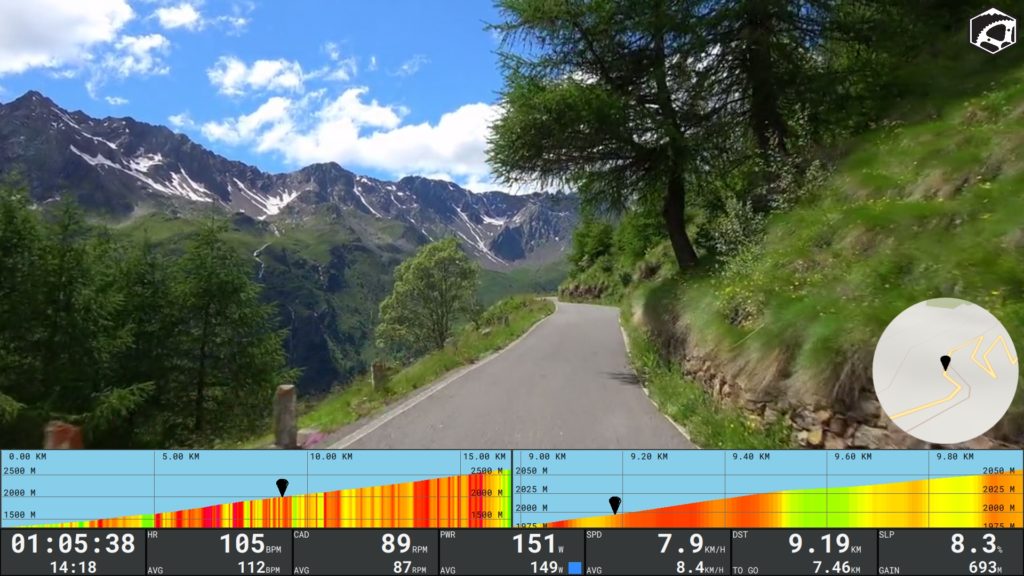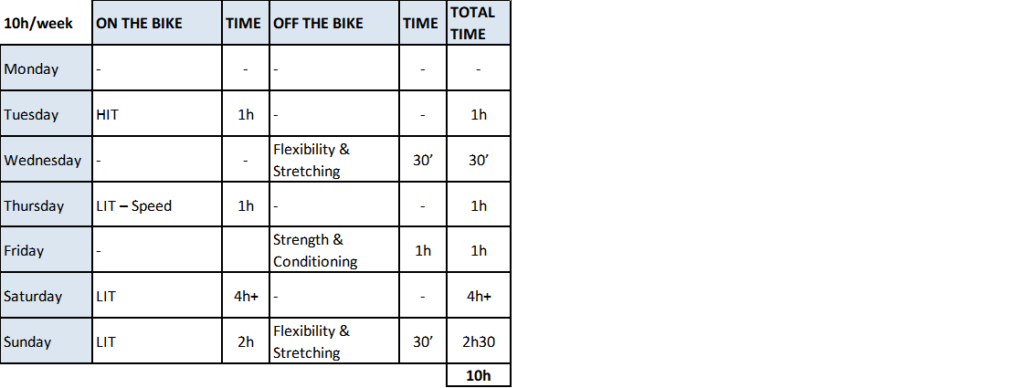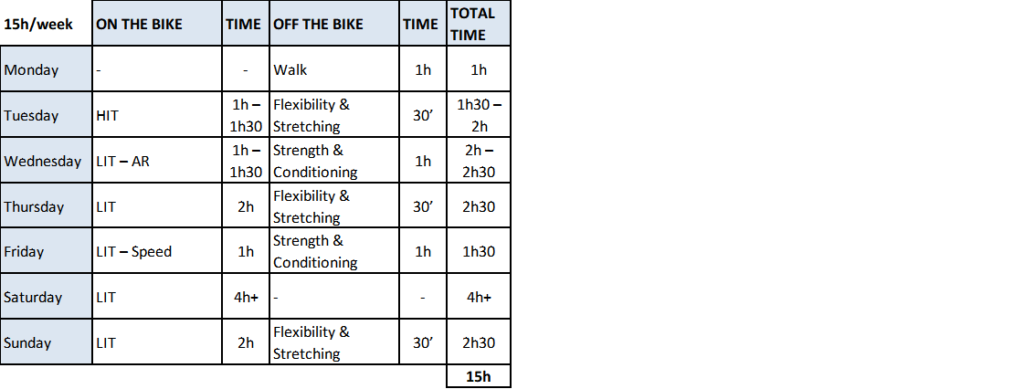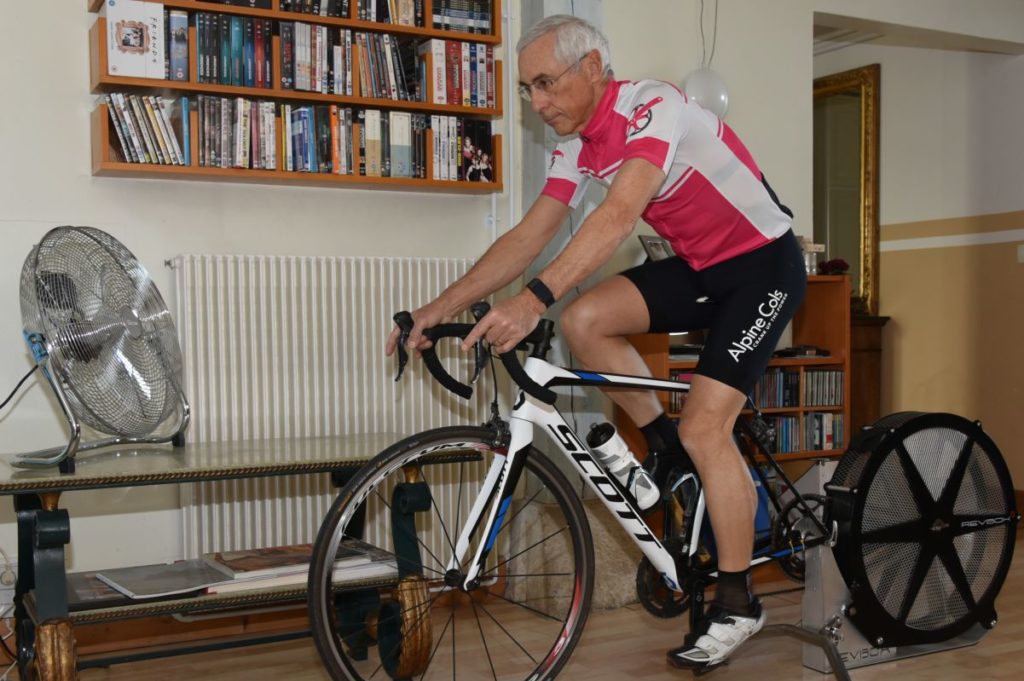
OBJECTIVE: come out of the lockdown fitter and stronger.
By Marvin Faure and Silas Cullen
At the time of writing it is currently against the law to cycle outdoors in many countries in Europe. This is obviously extremely frustrating to most of us, but it can’t be helped. So, let’s try to turn it round and see it as an opportunity!
With the right approach, you can come out of this fitter and stronger than had you continued as normal.
Start by setting yourself clear objectives.
We don’t know yet which – if any – events will take place this year, but pick your event and plan for it. For example, one of us (Marvin) has the Tour du Mont Blanc on July 18 as his 2020 objective. To finish, let alone do well, he must push his aerobic endurance and W/kg higher than they have ever been.
Is it a challenge to prepare the Tour du Mont Blanc on a turbo? Of course it is! Is it impossible? No: read on to learn how.
As usual, our training advice is primarily aimed at non-professional GranFondo and Sportive riders. The majority of these events take from 4 to 8 hours to finish, with events such as the Mallorca 312 or the Tour du Mont Blanc being longer still.
The Intensity Mix
The key to coming out of the lock-down stronger and better able to perform at a GranFondo is to do 80-90% of your training at Low Intensity (LIT).
In the next section we’ll get to how to do this on a turbo, but first let’s explain why doing so much LIT is important.
To use the common analogy, LIT is the cake and HIT is the icing. 95% of the nutritional value is in the cake, which must be made before it can be iced. By extension to endurance sports, you need to make the aerobic cake before you can add the sprint icing (for example).
This insight didn’t come from the lab, but from real-world research on elite athletes carried out in particular by endurance expert Dr. Seiler and his associates. Dr. Seiler coined the term “Polarised” to describe this training model, based on doing a mix of mostly “very easy” with some “very hard” training, but very little in between. For more details, read our previous articles on polarised training.
This approach is clearly highly effective at the elite level. Even though the term isn’t often mentioned, practically all professionals train in this way. At the amateur level research is limited but there is plenty of anecdotal evidence confirming that it makes sense for athletes at all levels.
In one interesting example the researchers did a direct comparison of polarised to threshold training. They divided twelve well-trained amateur cyclists into two groups of six and had them detrain for four weeks before following either a polarised plan or a threshold plan for six weeks. They were then detrained once more for four weeks before switching and following the other plan for another six weeks. At the end, each cyclist had thus followed both plans. The results were surprising: the polarised plan gave the best results, not only in terms of peak power output (+8% vs. +3%) but also in terms of threshold power (+9% vs. +2%). This was in spite of training less in the polarised plan (6.5h/week vs. 7.5h/week), and above all not doing any work at all at threshold in the polarised plan!
So is this the silver bullet?!
The challenge for many amateurs is that the approach actively discourages hard club rides and races on Zwift, because the efforts required fall in the no-go zone between LIT and HIT. And yet, these rides are the most fun. For many people, riding on the turbo has even become synonymous with racing on Zwift!
Our answer to this is a question: what’s more important to you? Is it your performance at a future event, or is it the fun you have from riding hard every time? It’s your call…
If you prioritise performance, and thus adopt the polarised model, your enjoyment will come from following a disciplined approach and seeing your performance improve. Dr. Seiler calls this “intensity discipline”. And as you get closer to your event, you can re-join those hard club rides to sharpen your race-readiness!
80/20 or 90/10?
The polarised approach calls for 80-90% of your training to be LIT and the rest HIT. The split is calculated on the basis of hours spent training, not time-in-zone, so a 1h interval session with only 20 mins at high intensity counts as 1h HIT.
There’s a big difference between 80/20 and 90/10, so let’s be smart about this. As always, adapt your training to the specific event you are training for, and to the time remaining before the event.
The longer your event and the further in the future, the greater the proportion of time you should spend in LIT.
As you get closer to the event (perhaps the last 6-8 weeks), you might increase the amount of HIT and include some race-specific preparation such as sweet-spot and fast group riding. The shorter and faster the event, the more of this you could do, so long as you have built a strong enough aerobic base (more on this below).
On the other hand, for very long events such as the Tour du Mont Blanc in particular (three times longer than a typical sportive: 15-18h for the majority) it is better to completely eliminate the HIT in the last few weeks and concentrate on the longest possible LIT rides, ideally two per weekend (for example 8h and 5h). These long rides are exhausting so should only be followed by two short recovery rides during the week, together with a couple of stretching sessions to maintain flexibility. If this suggestion surprises you, it’s perhaps there has been so much attention paid to interval training in the past few years that the need to build aerobic capacity has been overlooked. Click here for our guide to Training for the Tour du Mont Blanc.
Low Intensity on a Turbo
How to stay sane riding for hours on end at endurance pace on a turbo? The answer is to add variety, mix things up and keep ringing the changes.
As well as listening to music or watching the television, there are a bunch of cycling-specific things you can do to keep your session interesting and valuable, for example: vary the intensity through the full range from low Z1 to high Z2; vary the cadence from 45rpm all the way up to 100rpm (or higher in short bursts); vary the focus of your ride; try one-leg drills, use the sound of your turbo as a guide to improve your pedalling skills; try a different Virtual Reality service; and more…
Read here for the details: How to stay sane during long, low intensity rides on a Turbo

“Climbing” the Passo Gavia on BigRingVR
High Intensity
If you do respect the polarised approach you’ll be in great shape to really smash the HIT sessions and get the most out of them. But what sort of HIT should you do? The answer to this depends on numerous factors, including:
- The event you’re training for
- How far in the future is this event
- Your personal strengths and weaknesses
When properly applied, HIT develops numerous important qualities, such as:
- Strength endurance: the ability to create high torque (push hard on the pedals) repeatedly
- Power: the ability to hold a defined power output for a specific duration
- Pain tolerance: the ability to push through mental barriers
It is more important for long endurance events to be able to hold a high power output for several hours than it is to have an impressive one minute power, so the priority must be placed on relatively long intervals. As already mentioned above, for the Tour du Mont Blanc in particular, we recommend stopping all interval sessions 2 months before the event and focusing on LIT only. The longer you will take to finish your event, the more this advice is important. For example, a cyclist who will finish the Marmotte in about 8h should do more HIT than another person who will finish in 11h, simply because they will not be riding at the same intensity.
For shorter events where you need the ability to bridge gaps, hold a wheel and generally ride fast in a peloton, add several weeks of short, hard intervals (one to three minute efforts) in the pre-competition phase and before tapering. The principle is first to build a strong base of specific strength, and only then to add intensity.
See here for a variety of both LIT and HIT turbo sessions that are appropriate for long endurance events.
Strength and Conditioning
The lockdown could be the perfect opportunity to do a lot more off-the-bike Strength & Conditioning and really build your strength. Several weeks (or months) before the next competition is the ideal time to do this. Such exercises are an excellent complement to the work you do on your bike. They are more effective in building muscular strength, simply because you can create higher loads and hold them for longer periods than you can on the bike.
Strength & Conditioning is a specialist area, and as a cycling coach I’m not qualified to offer specific advice. I can say, however, that you don’t need a gym. There are dozens of simple isometric exercises you can do with just body weight, such as planks, Bulgarian squats, sitting against the wall and many others of varying levels of complexity. If you are not sure where to start, look at cycling-specific websites such as the British Cycling Insight Zone.
Beware: many strength and conditioning exercises can cause injury if your technique is incorrect. Make sure you understand the required technique for each exercise before beginning.
Combining Low Intensity Turbo Sessions with Strength & Conditioning
One way to reduce the tedium of long LIT sessions on the turbo is to mix things up a bit. Why not interlace your S&C sessions with easy spinning on the turbo, alternating every 10’-15’?
Alternating strength exercises with on-the-bike work during the same training session can help transfer the pure strength adaptations to cycling.
Weekly Plan
In the following tables we provide suggested weekly schedules for someone training for a long endurance event and with either 10h or 15h available to train (not including changing and showering time).
The ideal training mix for you depends on the event you are training for as well as your particular strengths and weaknesses. Think carefully about what would be most appropriate for you and adapt the plan accordingly. Contact us if you’d like help with this.
The order of the training sessions follows a deliberate pattern, but there’s nothing immutable about it. In particular, don’t hesitate to re-schedule the HIT session if you don’t feel rested and motivated: being up for it mentally is everything. Also, choose the time of day when you can devote 100% of your energy and concentration to it: perhaps early in the morning before your family is up!
PLAN FOR 9-10h TRAINING PER WEEK FOR A LONG ENDURANCE EVENT

- Total LIT: 7h
- Total HIT: 1h
- Total off the bike: 2h
- LIT/HIT = 88% / 12%
PLAN FOR 15-16h TRAINING PER WEEK FOR A LONG ENDURANCE EVENT

- Total LIT: 10h – 10h30
- Total HIT: 1h – 1h30
- Total off the bike: 4h
- LIT/HIT = 87% /13% – 91% / 9%
Remember to take regular recovery weeks in which you reduce the volume by 50% and eliminate the HIT (Every 4th week if <50, every 3rd week if > 50 and take longer to recover).
Listen to your body and reduce the training load if you feel severely fatigued. This is not the time to depress your immune system by over-training.
Nutrition and Hydration during the Lock-Down
The principles don’t change: adapt your calorie intake to your calorie expenditure (training load) and eat the widest variety possible of fresh, non-industrial food. While the latter may become more and more difficult to obtain (due to difficulties in shopping), the former remains the essential tool in managing your weight.
You should be eating more on days when you train hard and less on the easy or rest days. If you have a power meter it will give you an accurate number for the additional kJ and thus kcal that you spent in your training. An estimate based on heart rate is less accurate but better than a guess. Use these numbers as a guide for the extra amount you consume on the hard training days. Feed the machine: the quality of your training adaptation depends on it!
Days when you train at low intensity are opportunities to improve your fat-burning capacity. Consider doing your LIT sessions in a fasted state, before having breakfast, but make sure you are fully hydrated and eat a proper breakfast afterwards with plenty of carbohydrates to re-establish normal glucose levels in your blood.
Do not attempt HIT sessions fasted or in a carb-depleted condition. HIT sessions are fuelled primarily by glycogen. Both your performance during the session and your post-session adaptation will be enhanced by being properly fuelled with an adequate level of carbohydrate.
This is not the moment to go on a crash diet. Severe calorie restriction or eliminating certain micro-nutrients (or even macro-nutrients) from your diet may depress your immune system and will certainly leave you lacking in energy. If you do want to lose weight, make it very gradual through a slight calorie deficit only.
Concerning hydration, make sure you start your turbo sessions properly hydrated and you drink regularly throughout. For anything less than 2 hours there’s no need to use a carb-rich mix in your bottle, but if you are going to do 3h or more you should fuel as for a session on the road.
The HIT sessions are a special case: there is good evidence that a mouth-rinse with something sweet is just as effective as actually consuming the drink. It seems that the glucose receptors in the mouth send an anticipatory signal to the brain that fuel supplies are on the way so you can continue to exercise hard. Only use this strategy for relatively short HIT sessions!
Measuring your progress
Few things are better for your motivation than to see that you are making progress. All these tests can be done using the virtual power calculation available in the online cycling apps, but will of course be more accurate if you have your own power meter. We suggest several different types of test below. Pick the one (perhaps two) which is (are) most relevant to your event.
1. Power Duration tests
These tests are useful not only to measure your progress but also to update your critical power or FTP estimates and generate your Power Duration curve. Make sure you are fully rested and motivated before doing them. Do them under the same conditions every time and no more than once per month at the most. You will usually get the best result with a slight negative split (start slightly slow and finish very hard, completely emptying the tank).
A good test protocol is to do a 7 second peak power effort as part of your warm-up, and then 3 minute and 15 minute maximum efforts, with 1h of recovery in between. These two values are well-spaced for use in the critical power model.
Some people do 1’, 5’ and 20’ power tests, while others prefer 1’, 6’ and 12’ efforts. The exact durations aren’t magic, just be sure to use the same durations every time.
2. Intervals: how many?
The test here is, can you do more intervals at the same power? At the start you may be unable to do more than 4 x 15’ @FTP, but after a month you may be able to do a partial fifth interval and after 6-8 weeks you may be able to complete the fifth interval. This is an excellent indicator that your strength endurance has improved.
3. Intervals: how high?
For some people, rather than repeating intervals, it might be more relevant to achieve a higher power output. For example, if you aim to improve 15 min power at 55rpm you will be able to generate more torque for longer, thus improving both your strength and your strength endurance.
4. Cardiac drift
Cardiac drift is probably the best measure of your aerobic fitness. Also referred to as aerobic decoupling, it is a measure of whether your body’s output (power) remains proportional (“coupled”) to your input (heart rate) during a long steady-state effort at endurance pace. If the result is less than 5% the answer is yes, your aerobic fitness is good. You can test it either by riding at a steady HR for 1-2hrs, and seeing whether the power drops towards the end, or by riding at a steady power output for 1-2hrs and seeing whether your HR rises towards the end.
For the test to be valid it is essential that you be rested and well-hydrated. Always try to do follow-up tests under the same physical and environmental conditions.
5. Weight
This one is easy enough! Just remember to weigh yourself at the same time and under the same conditions: ideally as soon as you get up, after relieving yourself but before eating or drinking. Once a week is enough.
Coaching Support
It is definitely possible to come out of this difficult period stronger than you went in, but it means adapting your training and doing it right. If you’d like a professional cycling coach to help you through the process with a fully individual training plan and regular feedback, drop us a line or give us a call, and let’s have a chat.
Credit where credit is due: the original idea for this article was inspired by Alan Couzen’s blog Surviving the Quarantine.
